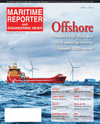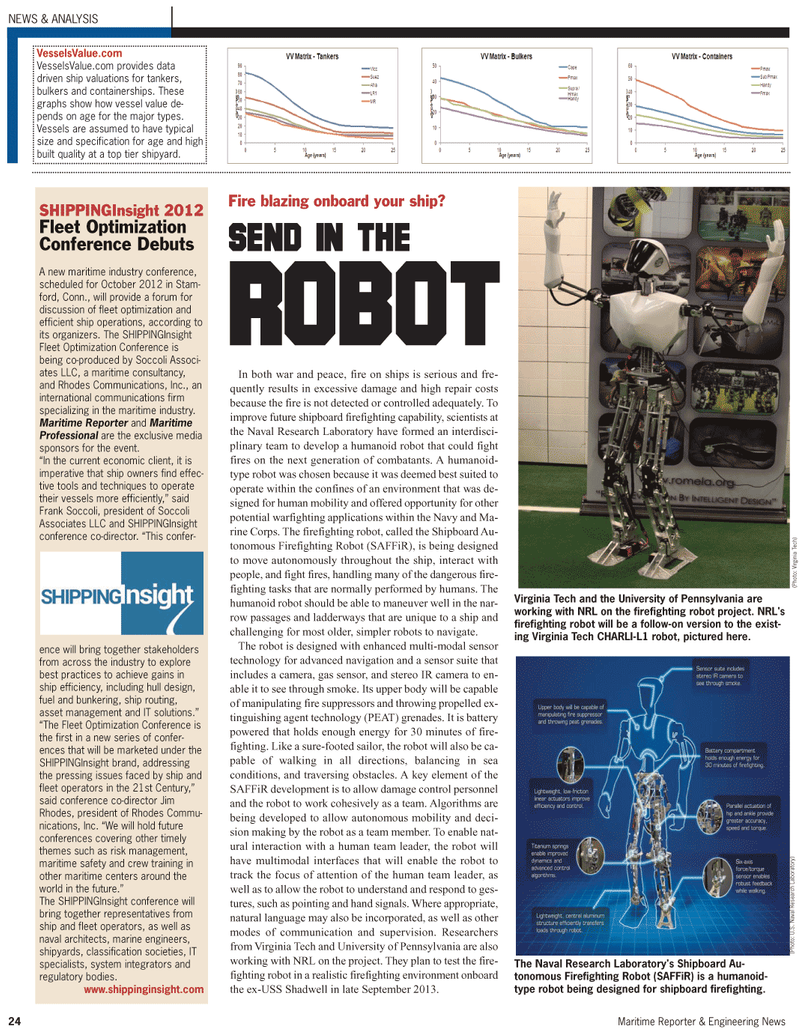
Page 24: of Maritime Reporter Magazine (April 2012)
Offshore Deepwater Annual
Read this page in Pdf, Flash or Html5 edition of April 2012 Maritime Reporter Magazine
In both war and peace, fire on ships is serious and fre- quently results in excessive damage and high repair costs because the fire is not detected or controlled adequately. To improve future shipboard firefighting capability, scientists at the Naval Research Laboratory have formed an interdisci- plinary team to develop a humanoid robot that could fight fires on the next generation of combatants. A humanoid- type robot was chosen because it was deemed best suited to operate within the confines of an environment that was de- signed for human mobility and offered opportunity for other potential warfighting applications within the Navy and Ma- rine Corps. The firefighting robot, called the Shipboard Au- tonomous Firefighting Robot (SAFFiR), is being designed to move autonomously throughout the ship, interact with people, and fight fires, handling many of the dangerous fire- fighting tasks that are normally performed by humans. The humanoid robot should be able to maneuver well in the nar- row passages and ladderways that are unique to a ship and challenging for most older, simpler robots to navigate. The robot is designed with enhanced multi-modal sensortechnology for advanced navigation and a sensor suite that includes a camera, gas sensor, and stereo IR camera to en- able it to see through smoke. Its upper body will be capable of manipulating fire suppressors and throwing propelled ex- tinguishing agent technology (PEAT) grenades. It is battery powered that holds enough energy for 30 minutes of fire- fighting. Like a sure-footed sailor, the robot will also be ca- pable of walking in all directions, balancing in sea conditions, and traversing obstacles. A key element of the SAFFiR development is to allow damage control personnel and the robot to work cohesively as a team. Algorithms are being developed to allow autonomous mobility and deci- sion making by the robot as a team member. To enable nat- ural interaction with a human team leader, the robot will have multimodal interfaces that will enable the robot to track the focus of attention of the human team leader, as well as to allow the robot to understand and respond to ges- tures, such as pointing and hand signals. Where appropriate, natural language may also be incorporated, as well as othermodes of communication and supervision. Researchersfrom Virginia Tech and University of Pennsylvania are also working with NRL on the project. They plan to test the fire- fighting robot in a realistic firefighting environment onboard the ex-USS Shadwell in late September 2013. 24Maritime Reporter & Engineering News NEWS & ANALYSIS VesselsValue.com VesselsValue.com provides data driven ship valuations for tankers,bulkers and containerships. Thesegraphs show how vessel value de-pends on age for the major types.Vessels are assumed to have typical size and specification for age and highbuilt quality at a top tier shipyard. SHIPPINGInsight 2012Fleet Optimization Conference Debuts A new maritime industry conference, scheduled for October 2012 in Stam-ford, Conn., will provide a forum for discussion of fleet optimization andefficient ship operations, according to its organizers. The SHIPPINGInsight Fleet Optimization Conference is being co-produced by Soccoli Associ- ates LLC, a maritime consultancy, and Rhodes Communications, Inc., aninternational communications firmspecializing in the maritime industry. Maritime Reporter and MaritimeProfessional are the exclusive media sponsors for the event.In the current economic client, it is imperative that ship owners find effec- tive tools and techniques to operatetheir vessels more efficiently,? said Frank Soccoli, president of Soccoli Associates LLC and SHIPPINGInsightconference co-director. This confer- ence will bring together stakeholdersfrom across the industry to explore best practices to achieve gains inship efficiency, including hull design, fuel and bunkering, ship routing, asset management and IT solutions.?The Fleet Optimization Conference is the first in a new series of confer-ences that will be marketed under theSHIPPINGInsight brand, addressing the pressing issues faced by ship and fleet operators in the 21st Century,? said conference co-director Jim Rhodes, president of Rhodes Commu- nications, Inc. We will hold future conferences covering other timely themes such as risk management,maritime safety and crew training in other maritime centers around the world in the future.? The SHIPPINGInsight conference will bring together representatives from ship and fleet operators, as well asnaval architects, marine engineers, shipyards, classification societies, IT specialists, system integrators andregulatory bodies. www.shippinginsight.com Send in theROBOTFire blazing onboard your ship? The Naval Research Laboratory's Shipboard Au- tonomous Firefighting Robot (SAFFiR) is a humanoid- type robot being designed for shipboard firefighting. (Photo: Virginia Tech) (Photo: U.S. Naval Research Laboratory) Virginia Tech and the University of Pennsylvania are working with NRL on the firefighting robot project. NRL's firefighting robot will be a follow-on version to the exist- ing Virginia Tech CHARLI-L1 robot, pictured here.

 23
23

 25
25
